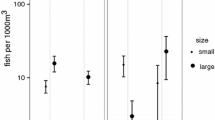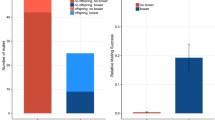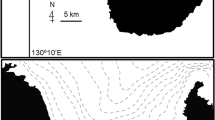Abstract
In most labrid fishes, large males with bright terminal phase (TP) coloration normally defend mating territories and pair spawn after following (i.e., courting) solitary females. It has also been reported that the TP males may abandon their territories and participate in group spawning when mating groups of small non-territorial males with drab initial phase (IP) coloration frequently intrude into the territories of TP males. In the similar situation of the present study, however, the territorial TP males of the threespot wrasse, Halichoeres trimaculatus, did not always participate in group spawning but continued pair spawning. Only the TP males that had few opportunities to encounter solitary IP individuals participated in group spawning, frequently following the mating groups of IP individuals. It is therefore suggested that group spawning of the territorial TP males is regarded as a tactic of making the best of the bad situation by the TP males with few opportunities to pair spawn in an area where group spawning dominates.



Similar content being viewed by others
References
Alonzo SH (2008) Female mate choice copying affects sexual selection in wild populations of the ocellated wrasse. Anim Behav 75:1715–1723. doi:10.1016/j.anbehav.2007.09.031
Breder C, Rosen DE (1966) Modes of reproduction in fishes. Natural History, Garden City
Choat JH, Robertson DR (1975) Protogynous hermaphroditism in fishes of the family Scaridae. In: Reinboth R (ed) Intersexuality in the animal kingdom. Springer-Verlag, Heidelberg, pp 263–283
Claydon J (2004) Spawning aggregations of coral reef fishes: characteristics, hypotheses, threats and management. Oceanogr Mar Biol 42:265–302
Colin PL, Bell LJ (1991) Aspects of the spawning of labrid and scarid fishes (Pisces: Labroidei) at Enewetak Atoll, Marshall Islands with notes on other families. Environ Biol Fish 31:229–260. doi:10.1007/BF00000690
Kuwamura T (1984) Social structure of the protogynous fish Labroides dimidiatus. Publ Seto Mar Biol Lab 29:117–177
Kuwamura T, Karino K, Nakashima Y (2000) Male morphological characteristics and mating success in a Protogynous coral reef fish, Halichoeres melanurus. J Ethol 18:17–23. doi:10.1007/s101640070019
Kuwamura T, Suzuki S, Tanaka N, Ouchi E, Karino K, Nakashima Y (2007) Sex change of primary males in a diandric labrid Halichoeres trimaculatus: coexistence of protandry and protogyny within a species. J Fish Biol 70:1898–1906. doi:10.1111/j.1095-8649.2007.01464.x
Masuda H, Amaoka K, Araga C, Uyeno T, Yoshino T (1984) The fishes of the Japanese archipelago. Tokai University Press, Tokyo
Nakazono A (1979) Studies on the sex reversal and spawning behavior of five species of Japanese labrid fishes. Rep Fish Res Lab Kyusyu Univ 4:1–64
Randall JE, Randall HA (1963) The spawning and early development of the Atlantic parrotfish Sparisoma rubripinne, with notes on other scarid and labrid fishes. Zoologica 48:49–60
Reinboth R (1973) Dualistic reproductive behavior in the protogynous wrasse Thalassoma bifasciatum and some observations on its day-night changeover. Helgol Wiss Meeresunters 24:174–191. doi:10.1007/BF01609510
Robertson DR, Hoffman SG (1977) The roles of female mate choice and predation in the mating systems of some tropical labroid fishes. Z Tierpsychol 45:298–320
Robertson DR, Warner RR (1978) Sexual patterns in the labrid fishes of the Western Caribbean. 2. The Parrotfish (Scridae). Smithson Contrib Zool 255:1–26
Sano M, Shimizu M (1984) Food habits of teleostean reef fishes in Okinawa Island, Southern Japan. Univ Mus, Univ Tokyo, Bull 25:1–128
Sara G, Bianchi CN, Morri C (2005) Mating behaviour the newly-established ornate wrasse Thalassoma pavo (Osteichthyes: Labridae) in the Ligurian Sea (North-western Mediterranean). J Mar Biol Assoc UK 85:191–196. doi:10.1017/S0025315405011057h
Shapiro DY, Marconato A, Yoshikawa T (1994) Sperm economy in a reef fish, Thalassoma bifasciatum. Ecology 75:1334–1344. doi:10.2307/1937458
Shibuno T, Chiba I, Gushima K, Kakuda S, Hashimoto H (1993) Reproductive behavior of the wrasse, Halichoeres marginatus, at Kuchierabu-jima. Jpn J Ichthyol 40:351–359
Smith PJ (1986) Spawning behaviour of snapper, Chrysophrys auratus, in captivity (Note). NZJ Mar Freshwater Res 20:513–515
Suzuki S, Toguchi K, Makino Y, Kuwamura T, Nakashima Y, Karino K (2008) Group spawning is a consequence of small males’ streaking into a sneaking pair: male alternative tactics in the threespot wrasse Halichoeres trimaculatus. J Ethol 26:397–404. doi:10.1007/s10164-008-0102-3
Taborsky M (1994) Sneakers, satellites, and helpers: parasitic and cooperative behavior in fish reproduction. Adv Study Behav 23:1–100. doi:10.1016/S0065-3454(08)60351-4
Thresher RE (1984) Reproduction in reef fishes. TFH, Neptune
van den Berghe EP, Warner RR (1989) The effects of mating system on male mate choice in a coral reef fish. Behav Ecol Sociobiol 24:409–415. doi:10.1007/BF00293269
van Rooij JM, Kroon FJ, Videler JJ (1996) The social and mating system of the herbivorous reef fish Sparisoma viride: One-male versus multi-male groups. Environ Biol Fish 47:353–378. doi:10.1007/BF00005050
Warner RR (1984) Mating behavior and hermaphroditism in coral reef fishes. Amer Sci 72:128–136
Warner RR, Hoffman SG (1980a) Population density and the economics of territorial defense in a coral reef fish. Ecology 61:772–780. doi:10.2307/1936747
Warner RR, Hoffman SG (1980b) Local population size as a determinant of mating system and sexual composition in two tropical marine fishes (Thalassoma spp.). Evolution 34:508–518
Warner RR, Robertson DR (1978) Sexual patterns in the labroid fishes of the Western Caribbean. 1. The Wrasses (Labridae). Smithsonian Contrib Zool 254:1–27
Warner RR, Schultz ET (1992) Sexual selection and male characteristics in the bluehead wrasse, Thalassoma bifasciatum: mating site acquisition, mating site defense, and female choice. Evolution 46:1421–1442
Warner RR, Swearer SE (1991) Social control of sex change in the bluehead wrasse, Thalassoma bifasciatum (Pisces: Labridae). Biol Bull 181:199–201
Warner RR, Robertson DR, Leigh EG (1975) Sex change and sexual selection. Science 190:633–638. doi:10.1126/science.1188360
Wernerus FM, Tessari V (1991) The influence of population density on the mating system of Thalassoma pavo, a protogynous Mediterranean labrid fish. PSZNI Mar Ecol 12:361–368. doi:10.1111/j.1439-0485.1991.tb00264.x
Acknowledgments
The Iriomote Laboratory of the Research Institute for Humanity and Nature and the Iriomote Station of the Tropical Biosphere Research Center at the University of the Ryukyus provided facilities for fieldwork. We are grateful to T. Sagawa, A. Fujiwara, and Y. Uchikawa for field assistance. This work was funded by the Iriomote Project of the Research Institute for Humanity and Nature in 2005. This is a contribution from the Iriomote Station. All field work complied with the current laws of Japan.
Author information
Authors and Affiliations
Corresponding author
Rights and permissions
About this article
Cite this article
Suzuki, S., Kuwamura, T., Nakashima, Y. et al. Social factors of group spawning as an alternative mating tactic in the territorial males of the threespot wrasse Halichoeres trimaculatus . Environ Biol Fish 89, 71–77 (2010). https://doi.org/10.1007/s10641-010-9691-0
Received:
Accepted:
Published:
Issue Date:
DOI: https://doi.org/10.1007/s10641-010-9691-0




